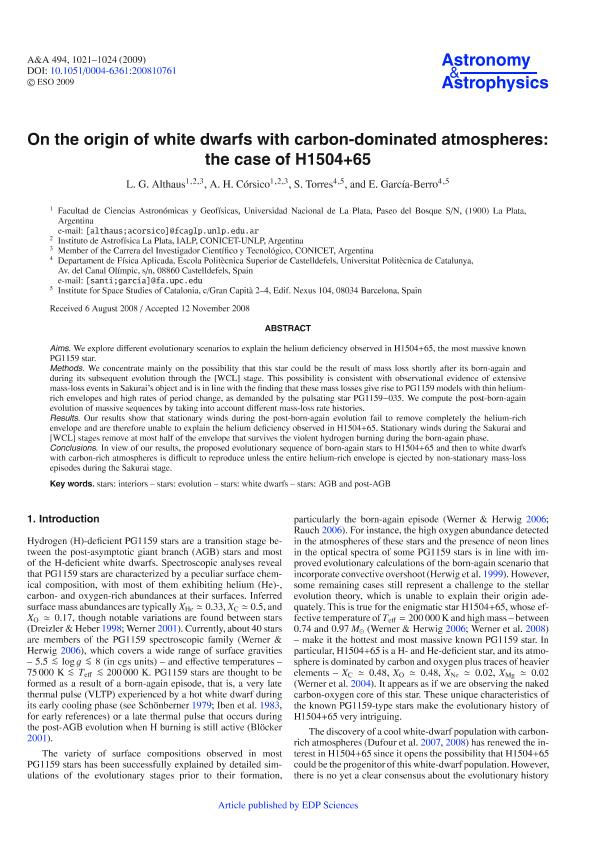Mostrar el registro sencillo del ítem
dc.contributor.author
Althaus, Leandro Gabriel

dc.contributor.author
Corsico, Alejandro Hugo

dc.contributor.author
Torres, S.
dc.contributor.author
García Berro, Enrique

dc.date.available
2018-04-23T13:19:53Z
dc.date.issued
2009-02
dc.identifier.citation
Althaus, Leandro Gabriel; Corsico, Alejandro Hugo; Torres, S.; García Berro, Enrique; On the origin of white dwarfs with carbon-dominated atmospheres: the case of H1504+65; EDP Sciences; Astronomy and Astrophysics; 494; 3; 2-2009; 1021-1024
dc.identifier.issn
0004-6361
dc.identifier.uri
http://hdl.handle.net/11336/42982
dc.description.abstract
Using the most recent results about white dwarfs (WDs) in ten open clusters, we revisit semiempirical estimates of the initial–final mass relation (IFMR) in star clusters, with emphasis on the use of stellar evolution models. We discuss the influence of these models on each step of the derivation. One intention of our work is to use consistent sets of calculations both for the isochrones and the WD cooling tracks. The second one is to derive the range of systematic errors arising from stellar evolution theory. This is achieved by using different sources for the stellar models and by varying physical assumptions and input data. Aims. We explore different evolutionary scenarios to explain the helium deficiency observed in H1504+65, the most massive known PG1159 star. Methods. We concentrate mainly on the possibility that this star could be the result of mass loss shortly after its born-again and during its subsequent evolution through the [WCL] stage. This possibility is consistent with observational evidence of extensive mass-loss events in Sakurai’s object and is in line with the finding that these mass losses give rise to PG1159 models with thin heliumrich envelopes and high rates of period change, as demanded by the pulsating star PG1159−035. We compute the post-born-again evolution of massive sequences by taking into account different mass-loss rate histories. Results. Our results show that stationary winds during the post-born-again evolution fail to remove completely the helium-rich envelope and are therefore unable to explain the helium deficiency observed in H1504+65. Stationary winds during the Sakurai and [WCL] stages remove at most half of the envelope that survives the violent hydrogen burning during the born-again phase. Conclusions. In view of our results, the proposed evolutionary sequence of born-again stars to H1504+65 and then to white dwarfs with carbon-rich atmospheres is difficult to reproduce unless the entire helium-rich envelope is ejected by non-stationary mass-loss episodes during the Sakurai stage.
dc.format
application/pdf
dc.language.iso
eng
dc.publisher
EDP Sciences

dc.rights
info:eu-repo/semantics/openAccess
dc.rights.uri
https://creativecommons.org/licenses/by-nc-sa/2.5/ar/
dc.subject
Interior Stars
dc.subject
Evolution of Stars
dc.subject
White Dwarfs
dc.subject
Post Agb Stars
dc.subject
Agb Stars
dc.subject.classification
Astronomía

dc.subject.classification
Ciencias Físicas

dc.subject.classification
CIENCIAS NATURALES Y EXACTAS

dc.title
On the origin of white dwarfs with carbon-dominated atmospheres: the case of H1504+65
dc.type
info:eu-repo/semantics/article
dc.type
info:ar-repo/semantics/artículo
dc.type
info:eu-repo/semantics/publishedVersion
dc.date.updated
2018-04-19T18:32:48Z
dc.journal.volume
494
dc.journal.number
3
dc.journal.pagination
1021-1024
dc.journal.pais
Francia

dc.journal.ciudad
Les Ulis, France
dc.description.fil
Fil: Althaus, Leandro Gabriel. Universidad Nacional de La Plata. Facultad de Ciencias Astronómicas y Geofísicas; Argentina. Consejo Nacional de Investigaciones Científicas y Técnicas. Centro Científico Tecnológico Conicet - La Plata. Instituto de Astrofísica La Plata. Universidad Nacional de La Plata. Facultad de Ciencias Astronómicas y Geofísicas. Instituto de Astrofísica La Plata; Argentina
dc.description.fil
Fil: Corsico, Alejandro Hugo. Universidad Nacional de La Plata. Facultad de Ciencias Astronómicas y Geofísicas; Argentina. Consejo Nacional de Investigaciones Científicas y Técnicas. Centro Científico Tecnológico Conicet - La Plata. Instituto de Astrofísica La Plata. Universidad Nacional de La Plata. Facultad de Ciencias Astronómicas y Geofísicas. Instituto de Astrofísica La Plata; Argentina
dc.description.fil
Fil: Torres, S.. Institute for Space Studies of Catalonia; España
dc.description.fil
Fil: García Berro, Enrique. Institute for Space Studies of Catalonia; España
dc.journal.title
Astronomy and Astrophysics

dc.relation.alternativeid
info:eu-repo/semantics/altIdentifier/doi/http://dx.doi.org/10.1051/0004-6361:200810761
dc.relation.alternativeid
info:eu-repo/semantics/altIdentifier/url/https://www.aanda.org/articles/aa/abs/2009/06/aa10761-08/aa10761-08.html
Archivos asociados
